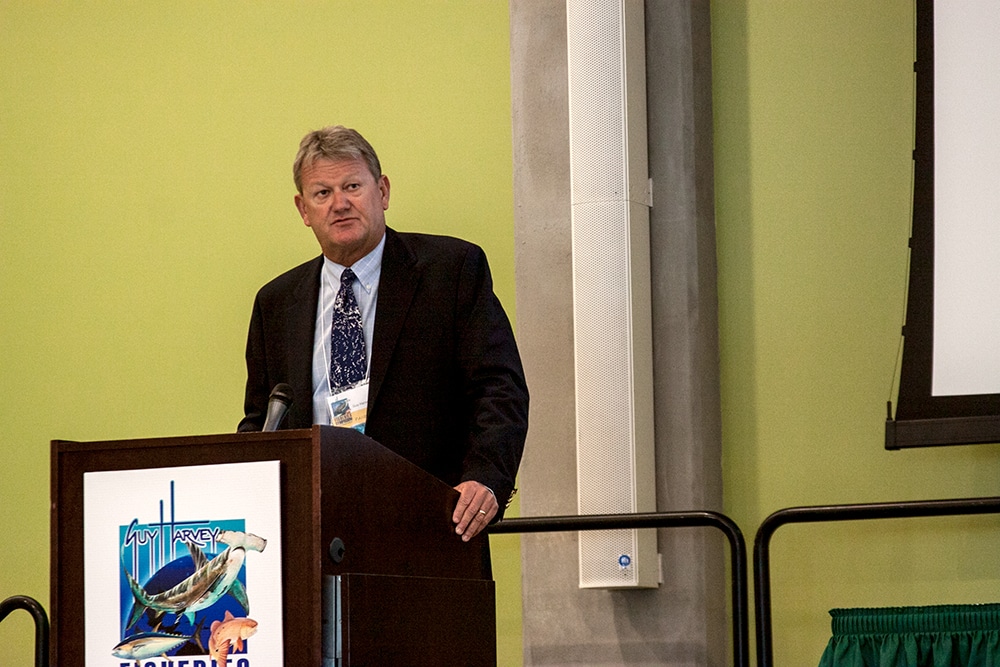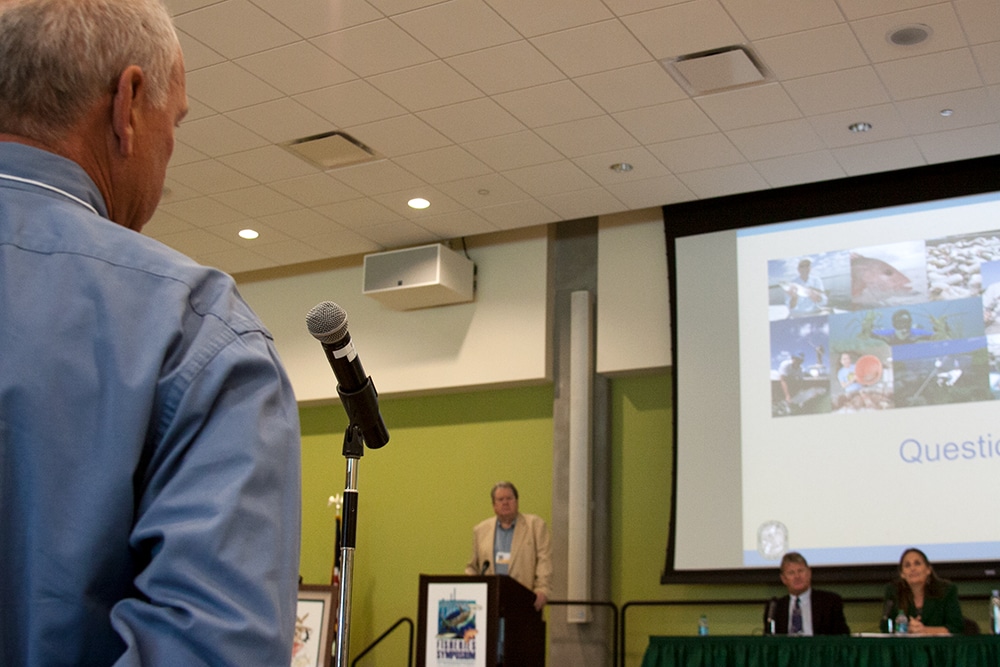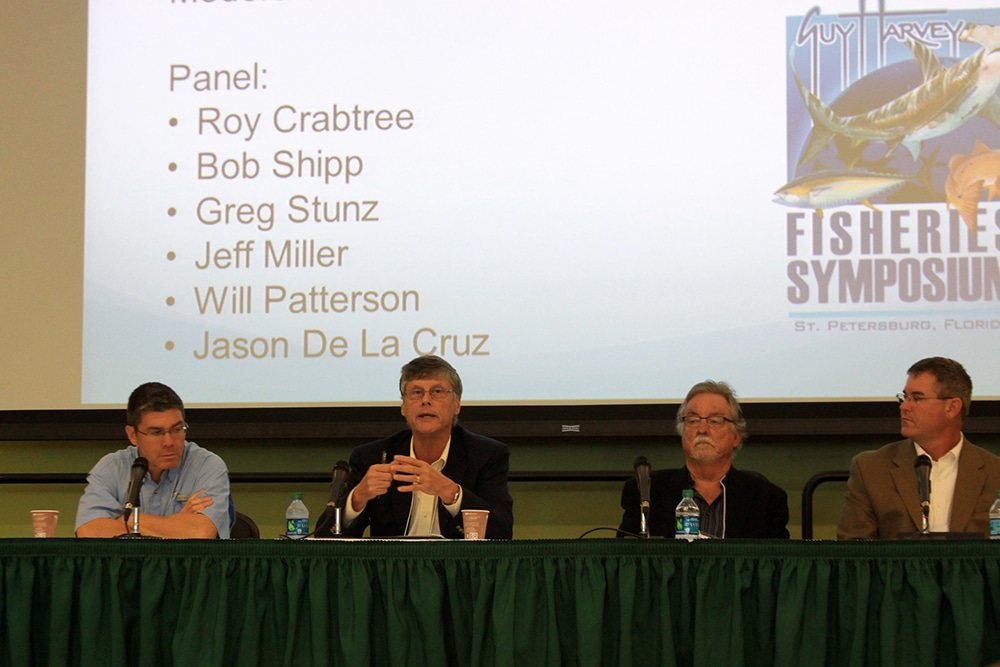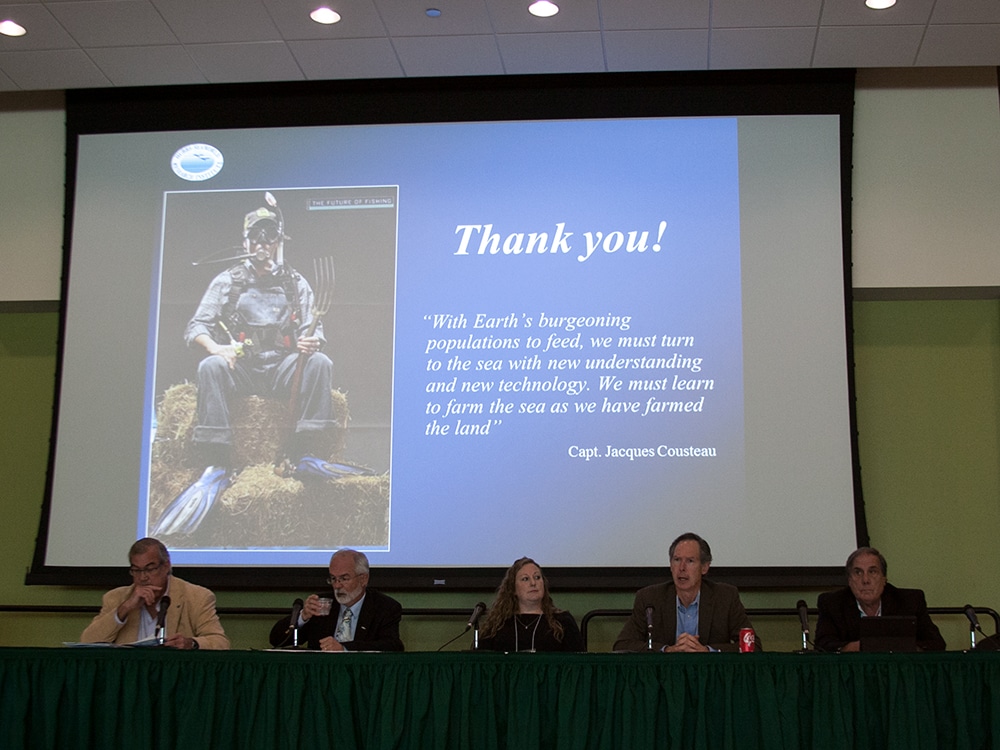Contentious issues such as red snapper and aquaculture highlighted the agenda at the Guy Harvey Fisheries Symposium at the University of South Florida in St. Petersburg, November 13 and 14.
Panels consisted of scientists, state and federal fishery-management representatives and commercial fishermen.
Eileen Sobeck, Assistant Administrator for NOAA Fisheries, was part of the panel discussing the updates on the fisheries issues on the Gulf. After the first day, she spoke with Sport Fishing concerning the usefulness of the symposium.
“I’m not usually the expert on the details of these issues. I have every confidence in Dr. Roy Crabtree, the NOAA Regional Administrator for the Southeast Region, and his staff to work through them and to have a really deep understanding, which then is given to me and then presented to the leadership in D.C.,” says Sobeck. “But, what I find most useful about this symposium is that it gives me a gut-check from my regional staff. Am I hearing the same message from the scientists to my staff? Is there filtering? Is this the true flavor?”
Sobeck says she thinks that her regional staff has been “good at communicating that to me, but hearing it firsthand and understanding how it affects people from day trip with an angler to making a living — is that it really matters.”
And according to Dr. Guy Harvey, in addition to the people and places affected by these issues, what also matters is having the data.
“The success of the symposium is that we managed to get a lot of different disciplines and user groups into one room to have an open discussion about the various issues,” says Harvey. “This year’s emphasis is on red snapper management. There’s been no doubt, in the years that artificial reefs have been deployed all over the Gulf — the biomass has dramatically increased. But, there hasn’t been a commensurated effort to determine how much of that biomass is out there right now. After all the discussions, we always go back to the science. We need more money to be spent on science; without the data you’re just guessing. It’s all about getting the data.”
Dr. Harvey looks at the participation of the federal and state fishery officials as a valuable opportunity to further educate them in the issues presented at the symposium.
“Unfortunately, as we know, elections can come and go,” says Harvey. “There’s a lot of re-education that has to happen with every new officer that comes in. Most of the people here, the scientists, have been around for a long time and know exactly what needs to happen. It’s incumbent upon these officials to listen because they have the very best advice coming at them.”
The panel that everyone eagerly anticipated involved the red snapper management issue. Panel members were:
- Dr. Roy Crabtree, Regional Administrator/Southeast of NOAA Fisheries
- Dr. Robert Shipp, Research Professor of University of South Alabama
- Dr. Greg Stunz, Professor and Endowed Chair at Texas A&M-Harte Research Institute
- Jeff Miller, CCA-Florida Government Relations Committee Chairman
- Dr. Will Patterson, Associate Professor of University of South Alabama
- Jason De La Cruz, Executive Director of GulfWild
Both Crabtree’s and Shipp’s presentations perked up many ears.
Crabtree mainly discussed the idea that “we need to figure out what we mean by ‘fixing the red snapper issue.’ Everyone — scientists, managers, fishermen — agrees that we have seen an amazing resurgence in red snapper in the Gulf of Mexico. Whether the stock is rebuilt — I don’t know, we have a new assessment coming out. And if it’s not rebuilt, I think we are pretty close to it.”
When it comes down to the difference between commercial and recreational fishing, Crabtree sees an imbalance.
“We do have a viable commercial fishery and it’s doing extremely well under the fishing- quota program, which took us 15 years to come to an agreement. Unfortunately, the recreational fishery is not working as well,” he says. “They are not sharing the benefits of the stock recovery at this point. Since the fish are so abundant and large across the Gulf, as a consequence of being so good and that the catch rates are up — it has translated into fewer fishing days to keep recreational fishing at its quota.”
Shipp presented outright solutions. Shipp and his team studied the Gulf and found approximately 17,000 artificial reefs. In addition to those reefs, they found that the fishery-dependent stock assessment was missing some of the age distribution.
“The reason why this happened was partly due to the fishery-dependent data of fishermen reporting their catch, and the fish were pretty small,” he says. “Using fishery-independent data, we found red snapper all the way up to 39 years old.”
Shipp gave three solutions:
1. Fish red snapper in 25 fathoms of water or shallower (Shipp has found that red snapper can live up to 100 fathoms), for 180 days, with a fixed two-bag limit.
2. Give management of snapper to the states. He said that, “states in the past have a great history of managing itsaltwater fish populations off their coasts.”
3. Combine 1 and 2 above: Let the states regulate it up to 25 fathoms.
The panel on aquaculture seemed near science fiction with the look of these globe-shaped, caged fish farms, but with the right support, aquaculture can become fact within the Gulf. The crux of the panel boiled down to: Where does our seafood come from?
The panel stated that 70% of the seafood in the United States comes from Asia. Most of the panelists said to fix that dependency, the caged fish farming could be one of the solutions. These cages look like fenced globes that will contain fish as well as a place where fish can be bred. It was presented as a good fix to shift our dependency away from importing fish indegenous to our waters.
An incident recounted by one panel member involved an American entrepreneur that moved to Mexico along the Yucatan Peninsula and ordered redfish (red drum) from an Israel hatchery to investigate farming methods for a business opportunity. Then the American farmed those redfish off the coast of Mexico, in turn, shipping them right back to the United States. This equals a carbon footprint that produces traveling emissions over two continents, the Atlantic and the Gulf of Mexico.
The aquaculture technique of farming in the ocean is being conducted in Florida, but only with shellfish. Paul Zajicek, Environmental Administrator of the Florida Department of Agriculture & Consumer Services, claims one of the main issues with conducting aquaculture with fish off Florida is that cages need to be in at least 100 feet of water. Zajicek continues to claim that the depth needed to conduct aquaculture would extend into federal territory.
Editor’s Note: This second-year symposium is one of a kind for the Gulf fishery. Just like anything in its infancy, it has room to grow into a full forum and hopefully one that will heed the calls to conservation issues. This discourse needs to happen, but the symposium lacked true debate, even though the entire symposium worked towards that goal. For the most part, the panels consisted of ones’ opinions, which is expected to get started, but the follow up of how to fuse opinions into a flowing solution was mostly invisible. Scientists, fishery-management and commercial fishermen were timed and moderated, just like any good debate, but the time that’s needed to further discuss a solution was amiss. The panelists wanted it. The audience wanted it. The symposium is a step in the right direction towards solutions, but the shoes worn were just a size too small. I am looking forward to what the future holds for this symposium.
The third annual Guy Harvey Fisheries Symposium is tentatively slated for September 2015.
For more information go to: www.guyharveyfisheriessymposium.com












